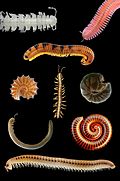Millipede
Millipede is a group of arthropods that are characterized by having two pairs of jointed legs on most body segments. They are known for their elongated cylindrical bodies and are part of the class Diplopoda.
Anatomy and physiology[edit]
Millipedes are typically brown, moving with a wave-like motion, and are detritivores, eating decaying leaves and other dead plant matter. Some species can secrete a toxic liquid, which can be harmful to predators and cause minor skin irritation in humans.
Body[edit]
The body of a millipede is divided into many segments, with most segments having two pairs of legs. The head is rounded and bears a pair of antennae. The body is protected by an exoskeleton, which must be periodically shed and re-grown as the millipede grows in size.
Legs[edit]
Each segment of a millipede's body (except for the first three) bears two pairs of legs. The number of leg-bearing segments varies widely, from 11 to over 100, depending on the species.
Reproduction[edit]
Millipedes reproduce sexually, with males depositing a spermatophore for the female to take up. In some species, the male has modified legs called gonopods, which are used to transfer the spermatophore to the female.
Behavior and ecology[edit]
Millipedes are generally slow-moving detritivores, eating decaying leaves and other dead plant matter. They can be found in a variety of habitats where decaying plant material is abundant, such as forests, savannas, and grasslands.
Human interaction[edit]
While millipedes are harmless and non-aggressive towards humans, some species can secrete a toxic liquid which can cause skin irritation. They are often considered pests in greenhouses and gardens where they can cause damage to seedlings.
Taxonomy[edit]
Millipedes belong to the class Diplopoda, which is divided into sixteen orders and approximately 140 families. There are an estimated 12,000 species of millipedes worldwide.
See also[edit]
References[edit]
<references />
|
|
|
Millipede[edit]
-
Millipede collage
-
Millipede order species comparison
-
Octoglena sierra (Family Polyzoniidae)
-
Anadenobolus monilicornis
-
Harpaphe haydeniana
-
Pauropus huxleyi
-
Millipede centipede side-by-side
-
Millipede body types
-
Millipede anterior anatomy
-
Paranota comparison
-
Female Illacme plenipes with 618 legs
-
Mating millipedes
Ad. Transform your life with W8MD's Budget GLP-1 injections from $75


W8MD offers a medical weight loss program to lose weight in Philadelphia. Our physician-supervised medical weight loss provides:
- Weight loss injections in NYC (generic and brand names):
- Zepbound / Mounjaro, Wegovy / Ozempic, Saxenda
- Most insurances accepted or discounted self-pay rates. We will obtain insurance prior authorizations if needed.
- Generic GLP1 weight loss injections from $75 for the starting dose.
- Also offer prescription weight loss medications including Phentermine, Qsymia, Diethylpropion, Contrave etc.
NYC weight loss doctor appointmentsNYC weight loss doctor appointments
Start your NYC weight loss journey today at our NYC medical weight loss and Philadelphia medical weight loss clinics.
- Call 718-946-5500 to lose weight in NYC or for medical weight loss in Philadelphia 215-676-2334.
- Tags:NYC medical weight loss, Philadelphia lose weight Zepbound NYC, Budget GLP1 weight loss injections, Wegovy Philadelphia, Wegovy NYC, Philadelphia medical weight loss, Brookly weight loss and Wegovy NYC
|
WikiMD's Wellness Encyclopedia |
| Let Food Be Thy Medicine Medicine Thy Food - Hippocrates |
Medical Disclaimer: WikiMD is not a substitute for professional medical advice. The information on WikiMD is provided as an information resource only, may be incorrect, outdated or misleading, and is not to be used or relied on for any diagnostic or treatment purposes. Please consult your health care provider before making any healthcare decisions or for guidance about a specific medical condition. WikiMD expressly disclaims responsibility, and shall have no liability, for any damages, loss, injury, or liability whatsoever suffered as a result of your reliance on the information contained in this site. By visiting this site you agree to the foregoing terms and conditions, which may from time to time be changed or supplemented by WikiMD. If you do not agree to the foregoing terms and conditions, you should not enter or use this site. See full disclaimer.
Credits:Most images are courtesy of Wikimedia commons, and templates, categories Wikipedia, licensed under CC BY SA or similar.
Translate this page: - East Asian
中文,
日本,
한국어,
South Asian
हिन्दी,
தமிழ்,
తెలుగు,
Urdu,
ಕನ್ನಡ,
Southeast Asian
Indonesian,
Vietnamese,
Thai,
မြန်မာဘာသာ,
বাংলা
European
español,
Deutsch,
français,
Greek,
português do Brasil,
polski,
română,
русский,
Nederlands,
norsk,
svenska,
suomi,
Italian
Middle Eastern & African
عربى,
Turkish,
Persian,
Hebrew,
Afrikaans,
isiZulu,
Kiswahili,
Other
Bulgarian,
Hungarian,
Czech,
Swedish,
മലയാളം,
मराठी,
ਪੰਜਾਬੀ,
ગુજરાતી,
Portuguese,
Ukrainian














